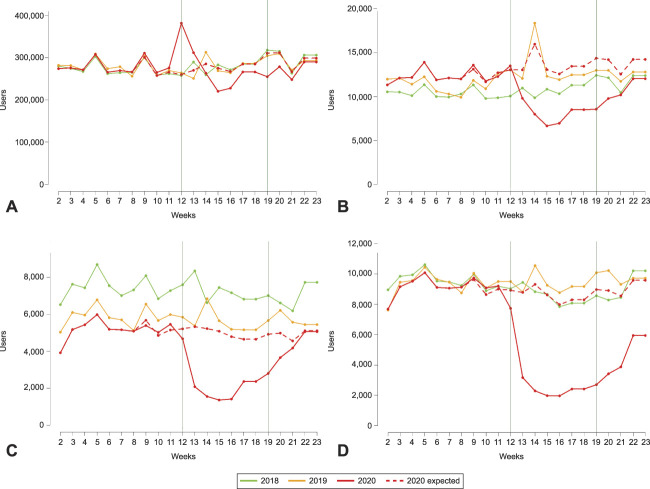Abstract
Hormonal medication dispensations decreased substantially during lockdown and after in France, especially for emergency contraception, levonorgestrel-releasing intrauterine devices, and ovulation inductors.
INTRODUCTION
In France, more than 2,650,750 confirmed cases of coronavirus disease 2019 (COVID-19) and 65,000 deaths had been reported as of January 5, 2021. French authorities decided to impose a national lockdown from March 17 to May 11, 2020.1 French people were not allowed to leave their homes unless necessary, but health structures and pharmacies remained open although focusing on pandemic management. We examined the use of oral contraceptives (OC), emergency contraception, levonorgestrel-releasing intrauterine devices (LNG-IUDs), and ovulation inductors in France during lockdown and 1 month after. We hypothesized that this period could have had a deleterious effect on reproductive health care access.
METHODS
We analyzed data from the National Health Data System, which provides information on health insurance claims for 99.5% of the population living in France. This database includes individual information on outpatient medical care and drugs. The French lockdown began on March 17, 2020, and was lifted starting on May 11, 2020. We screened all pharmacies' dispensations between January 1, 2018, and June 7 in 2018, 2019, and 2020. Numbers of OC, emergency contraception, LNG-IUD, and ovulation inductor dispensations were measured every week and compared with the numbers of dispensations expected in 2020 without lockdown, on the basis of 2018 and 2019 usage and taking into account the annual trend.
RESULTS
Oral contraceptive dispensation increased during the first 2 weeks of lockdown compared with the expected consumption (+46.7% and +15.5%, respectively) and then decreased from March 31 to May 11, 2020 (Appendices 1 and 2, available online at http://links.lww.com/AOG/C187). Compared with previous years, use of emergency contraception fell during lockdown; we thus estimated that 38,429 French women did not take emergency contraception during lockdown.
Similar patterns were observed for LNG-IUDs, with 21,250 fewer LNG-IUDs dispensed than expected (to a maximum of −73% between April 6 and April 12, 2020). Use of ovulation inductors fell sharply during the entire lockdown period. It is estimated that 44,510 women did not benefit from ovulation inductors during lockdown compared with previous years (Fig. 1).
Fig. 1. Observed and expected numbers of oral contraceptive (A), emergency contraception (B), levonorgestrel-releasing intrauterine device (C), and ovulation inductor (D) users during the first 23 weeks of 2018, 2019, and 2020 in France. Vertical lines delimit the French lockdown period.
Roland. Hormonal Medication Use During French Lockdown. Obstet Gynecol 2021.
One month after lockdown began to end, numbers of dispensations remained lower, albeit to a lesser extent. More than 11,000 women did not take emergency contraception as expected, 1,807 did not use LNG-IUDs, and 17,431 did not benefit from ovulation inductors.
DISCUSSION
Numbers of OC prescriptions increased more than expected during the first 2 weeks of lockdown, then decreased until the end of lockdown. Use of emergency contraception, LNG-IUDs, and ovulation inductors decreased more substantially than expected during lockdown and after, to a final negative balance. At the beginning of lockdown, the surge in OC consumption was likely due to stockpiling behaviors and to the exceptional authorization given by French authorities to pharmacists to dispense expired prescriptions.2
Even if lockdown might have had a negative effect on sexual activity,3 and even though pharmacies remained open and emergency contraception was available, unplanned pregnancies may be more likely to happen given the decrease in emergency contraception and OC use, and access to safe abortion care is more complicated during the pandemic.4 The reduced access to long-acting contraception, such as LNG-IUDs, could have the same consequences. To meet a potentially rising abortion need, the French government has taken emergency measures by extending the legal ambulatory medical abortion time limit.5
Finally, ovulation inductor dispensations decreased, probably due to postponement of elective fertility treatment. In France, neonates conceived using assisted reproductive technology represent about 3% of the total live-birth rate each year.6 Having prompt access to a postpandemic restart of infertility treatments would help to reduce the deleterious effect of the lockdown on couples with infertility.
Our study showed that lockdown substantially affected hormonal medication use. The major concerns are with medications that require the intervention of a health care professional (LNG-IUDs, ovulation inductors, abortion if no access to emergency contraception). Continued monitoring in 2020 is essential to explore the long-term effect of the lockdown on reproductive health in France.
Footnotes
Financial Disclosure The authors did not report any potential conflicts of interest.
Each author has confirmed compliance with the journal's requirements for authorship.
Peer reviews and author correspondence are available at http://links.lww.com/AOG/C188.
Figure.
No available caption
REFERENCES
- 1.Salje H, Tran Kiem C, Lefrancq N, Courtejoie N, Bosetti P, Paireau J, et al. Estimating the burden of SARS-CoV-2 in France [published erratum appears in Science 2020;368(6498)]. Science 2020;369:208–11. doi: 10.1126/science.abc3517. [DOI] [PMC free article] [PubMed] [Google Scholar]
- 2.Arrêté du 14 Mars 2020 portant diverses mesures relatives à la lutte contre la propagation du virus covid-19. Accessed July 2, 2020. https://www.legifrance.gouv.fr/affichTexte.do?cidTexte=JORFTEXT000041722917&categorieLien=id
- 3.Li W, Li G, Xin C, Wang Y, Yang S. Challenges in the practice of sexual medicine in the time of COVID-19 in China. J Sex Med 2020;17:1225–8. doi: 10.1016/j.jsxm.2020.04.380 [DOI] [PMC free article] [PubMed] [Google Scholar]
- 4.Bayefsky MJ, Bartz D, Watson KL. Abortion during the Covid-19 pandemic—ensuring access to an essential health service. N Engl J Med 2020;382:e47. doi: 10.1056/NEJMp2008006 [DOI] [PubMed] [Google Scholar]
- 5.Arrêté du 14 Avril 2020 complétant l'arrêté du 23 Mars 2020 prescrivant les mesures d'organisation et de fonctionnement du système de santé nécessaires pour faire face à l'épidémie de covid-19 dans le cadre de l'état d'urgence sanitaire. Accessed July 2, 2020. https://www.legifrance.gouv.fr/affichTexte.do?cidTexte=JORFTEXT000041798289&categorieLien=id
- 6.de La Rochebrochard E, Troude P, Bailly E, Guibert J, Bouyer J. What are the chances of having a child during or after IVF treatment? A retrospective cohort study in France [in French]. BEH 2011;23–24:274–7. [Google Scholar]




